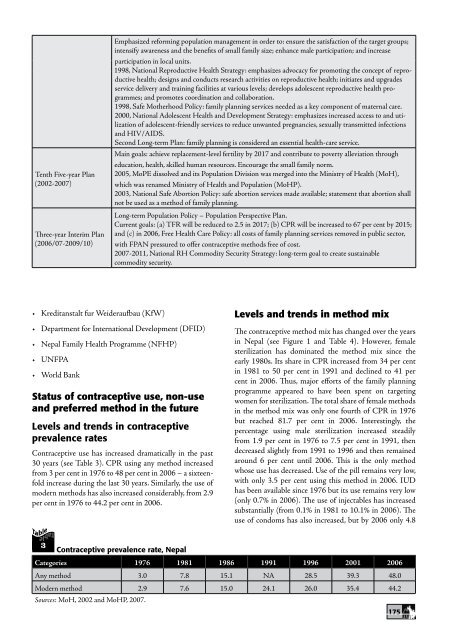Family Planning in Asia and the Pacific - International Council on ...
Family Planning in Asia and the Pacific - International Council on ... Family Planning in Asia and the Pacific - International Council on ...
174
eproductivehealth; designs
- Page 133 and 134: the Family
- Page 135 and 136: National Institute for Population R
- Page 137 and 138: IndiaIndiaFamily <
- Page 139: IntroductionThe use of contraceptiv
- Page 142 and 143: TableTable2Indicators of tra<strong
- Page 144 and 145: FigureFigureFigure1Contraceptive pr
- Page 146 and 147: TableTable5Indicators of contracept
- Page 148 and 149: TableTable6Adjusted odds ratios for
- Page 150 and 151: FigureFigure3Contraceptive prevalen
- Page 152 and 153: TableTable7Adjusted and</st
- Page 154 and 155: the north
- Page 156 and 157: TableTable10Differences between nor
- Page 158 and 159: TableTable11 Total fertility rate <
- Page 160 and 161: End Note1The first camp was success
- Page 162 and 163: 152
- Page 164 and 165: 154
- Page 166 and 167: Figure1980s and ex
- Page 168 and 169: health care and ed
- Page 170 and 171: assistance from UNFPA and</
- Page 172 and 173: in CPR. Likewise,
- Page 174 and 175: International supp
- Page 176 and 177: in development has
- Page 178 and 179: __________ (2007). Population <stro
- Page 180 and 181: 170
- Page 182 and 183: TableTable2What has the</st
- Page 186 and 187: per cent of women reported us<stron
- Page 188 and 189: is provider bias that such methods
- Page 190 and 191: TableTable7skewed distribution of h
- Page 192 and 193: TableTable8TableTable9182
- Page 194 and 195: that of the nation
- Page 196 and 197: TableTable12 7some policies that ex
- Page 198 and 199: The system guides the</stro
- Page 200 and 201: FigureFigure4Total donor expenditur
- Page 202 and 203: FigureFigureagain
- Page 204 and 205: Impact of family plannin</s
- Page 206 and 207: marketing of contr
- Page 208 and 209: United States Agency for In
- Page 210 and 211: 200
- Page 212 and 213: acceptable. From an NGO perspective
- Page 214 and 215: FigureThis trend of limited donor f
- Page 216 and 217: Figureto have the
- Page 218 and 219: FigureFigure5Percentage change <str
- Page 220 and 221: FigureFigure6Desire to limit childb
- Page 222 and 223: coordination betwe
- Page 224 and 225: the 1980s
- Page 226 and 227: Policy Management.__________ (n.d.,
- Page 228 and 229: 218
- Page 230 and 231: Population Activities (UNFPA) for a
- Page 232 and 233: where family plannin</stron
eproductivehealth; designs <str<strong>on</strong>g>and</str<strong>on</strong>g> c<strong>on</strong>ducts research activities <strong>on</strong> reproductive health; <str<strong>on</strong>g>in</str<strong>on</strong>g>itiates <str<strong>on</strong>g>and</str<strong>on</strong>g> upgradesservice delivery <str<strong>on</strong>g>and</str<strong>on</strong>g> tra<str<strong>on</strong>g>in</str<strong>on</strong>g><str<strong>on</strong>g>in</str<strong>on</strong>g>g facilities at various levels; develops adolescent reproductive health programmes;<str<strong>on</strong>g>and</str<strong>on</strong>g> promotes coord<str<strong>on</strong>g>in</str<strong>on</strong>g>ati<strong>on</strong> <str<strong>on</strong>g>and</str<strong>on</strong>g> collaborati<strong>on</strong>.1998, Safe Mo<str<strong>on</strong>g>the</str<strong>on</strong>g>rhood Policy: family plann<str<strong>on</strong>g>in</str<strong>on</strong>g>g services needed as a key comp<strong>on</strong>ent of maternal care.2000, Nati<strong>on</strong>al Adolescent Health <str<strong>on</strong>g>and</str<strong>on</strong>g> Development Strategy: emphasizes <str<strong>on</strong>g>in</str<strong>on</strong>g>creased access to <str<strong>on</strong>g>and</str<strong>on</strong>g> utilizati<strong>on</strong>of adolescent-friendly services to reduce unwanted pregnancies, sexually transmitted <str<strong>on</strong>g>in</str<strong>on</strong>g>fecti<strong>on</strong>s<str<strong>on</strong>g>and</str<strong>on</strong>g> HIV/AIDS.Sec<strong>on</strong>d L<strong>on</strong>g-term Plan: family plann<str<strong>on</strong>g>in</str<strong>on</strong>g>g is c<strong>on</strong>sidered an essential health-care service.Kreditanstalt fur Weideraufbau (KfW)Department for <str<strong>on</strong>g>Internati<strong>on</strong>al</str<strong>on</strong>g> Development (DFID)Nepal <str<strong>on</strong>g>Family</str<strong>on</strong>g> Health Programme (NFHP)UNFPAWorld BankStatus of c<strong>on</strong>traceptive use, n<strong>on</strong>-use<str<strong>on</strong>g>and</str<strong>on</strong>g> preferred method <str<strong>on</strong>g>in</str<strong>on</strong>g> <str<strong>on</strong>g>the</str<strong>on</strong>g> futureLevels <str<strong>on</strong>g>and</str<strong>on</strong>g> trends <str<strong>on</strong>g>in</str<strong>on</strong>g> c<strong>on</strong>traceptiveprevalence ratesC<strong>on</strong>traceptive use has <str<strong>on</strong>g>in</str<strong>on</strong>g>creased dramatically <str<strong>on</strong>g>in</str<strong>on</strong>g> <str<strong>on</strong>g>the</str<strong>on</strong>g> past30 years (see Table 3). CPR us<str<strong>on</strong>g>in</str<strong>on</strong>g>g any method <str<strong>on</strong>g>in</str<strong>on</strong>g>creasedfrom 3 per cent <str<strong>on</strong>g>in</str<strong>on</strong>g> 1976 to 48 per cent <str<strong>on</strong>g>in</str<strong>on</strong>g> 2006 – a sixteenfold<str<strong>on</strong>g>in</str<strong>on</strong>g>crease dur<str<strong>on</strong>g>in</str<strong>on</strong>g>g <str<strong>on</strong>g>the</str<strong>on</strong>g> last 30 years. Similarly, <str<strong>on</strong>g>the</str<strong>on</strong>g> use ofmodern methods has also <str<strong>on</strong>g>in</str<strong>on</strong>g>creased c<strong>on</strong>siderably, from 2.9per cent <str<strong>on</strong>g>in</str<strong>on</strong>g> 1976 to 44.2 per cent <str<strong>on</strong>g>in</str<strong>on</strong>g> 2006.TableLevels <str<strong>on</strong>g>and</str<strong>on</strong>g> trends <str<strong>on</strong>g>in</str<strong>on</strong>g> method mixThe c<strong>on</strong>traceptive method mix has changed over <str<strong>on</strong>g>the</str<strong>on</strong>g> years<str<strong>on</strong>g>in</str<strong>on</strong>g> Nepal (see Figure 1 <str<strong>on</strong>g>and</str<strong>on</strong>g> Table 4). However, femalesterilizati<strong>on</strong> has dom<str<strong>on</strong>g>in</str<strong>on</strong>g>ated <str<strong>on</strong>g>the</str<strong>on</strong>g> method mix s<str<strong>on</strong>g>in</str<strong>on</strong>g>ce <str<strong>on</strong>g>the</str<strong>on</strong>g>early 1980s. Its share <str<strong>on</strong>g>in</str<strong>on</strong>g> CPR <str<strong>on</strong>g>in</str<strong>on</strong>g>creased from 34 per cent<str<strong>on</strong>g>in</str<strong>on</strong>g> 1981 to 50 per cent <str<strong>on</strong>g>in</str<strong>on</strong>g> 1991 <str<strong>on</strong>g>and</str<strong>on</strong>g> decl<str<strong>on</strong>g>in</str<strong>on</strong>g>ed to 41 percent <str<strong>on</strong>g>in</str<strong>on</strong>g> 2006. Thus, major efforts of <str<strong>on</strong>g>the</str<strong>on</strong>g> family plann<str<strong>on</strong>g>in</str<strong>on</strong>g>gprogramme appeared to have been spent <strong>on</strong> target<str<strong>on</strong>g>in</str<strong>on</strong>g>gwomen for sterilizati<strong>on</strong>. The total share of female methods<str<strong>on</strong>g>in</str<strong>on</strong>g> <str<strong>on</strong>g>the</str<strong>on</strong>g> method mix was <strong>on</strong>ly <strong>on</strong>e fourth of CPR <str<strong>on</strong>g>in</str<strong>on</strong>g> 1976but reached 81.7 per cent <str<strong>on</strong>g>in</str<strong>on</strong>g> 2006. Interest<str<strong>on</strong>g>in</str<strong>on</strong>g>gly, <str<strong>on</strong>g>the</str<strong>on</strong>g>percentage us<str<strong>on</strong>g>in</str<strong>on</strong>g>g male sterilizati<strong>on</strong> <str<strong>on</strong>g>in</str<strong>on</strong>g>creased steadilyfrom 1.9 per cent <str<strong>on</strong>g>in</str<strong>on</strong>g> 1976 to 7.5 per cent <str<strong>on</strong>g>in</str<strong>on</strong>g> 1991, <str<strong>on</strong>g>the</str<strong>on</strong>g>ndecreased slightly from 1991 to 1996 <str<strong>on</strong>g>and</str<strong>on</strong>g> <str<strong>on</strong>g>the</str<strong>on</strong>g>n rema<str<strong>on</strong>g>in</str<strong>on</strong>g>edaround 6 per cent until 2006. This is <str<strong>on</strong>g>the</str<strong>on</strong>g> <strong>on</strong>ly methodwhose use has decreased. Use of <str<strong>on</strong>g>the</str<strong>on</strong>g> pill rema<str<strong>on</strong>g>in</str<strong>on</strong>g>s very low,with <strong>on</strong>ly 3.5 per cent us<str<strong>on</strong>g>in</str<strong>on</strong>g>g this method <str<strong>on</strong>g>in</str<strong>on</strong>g> 2006. IUDhas been available s<str<strong>on</strong>g>in</str<strong>on</strong>g>ce 1976 but its use rema<str<strong>on</strong>g>in</str<strong>on</strong>g>s very low(<strong>on</strong>ly 0.7% <str<strong>on</strong>g>in</str<strong>on</strong>g> 2006). The use of <str<strong>on</strong>g>in</str<strong>on</strong>g>jectables has <str<strong>on</strong>g>in</str<strong>on</strong>g>creasedsubstantially (from 0.1% <str<strong>on</strong>g>in</str<strong>on</strong>g> 1981 to 10.1% <str<strong>on</strong>g>in</str<strong>on</strong>g> 2006). Theuse of c<strong>on</strong>doms has also <str<strong>on</strong>g>in</str<strong>on</strong>g>creased, but by 2006 <strong>on</strong>ly 4.8Table3175



